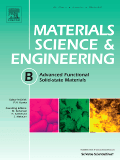
Materials Science and Engineering B-Advanced Functional Solid-State Materials
Scope & Guideline
Advancing the Future of Solid-State Materials
Introduction
Aims and Scopes
- Materials Synthesis and Characterization:
The journal frequently publishes research on novel synthesis techniques for advanced materials, including nanomaterials, composites, and thin films. This includes methods such as sol-gel processes, hydrothermal synthesis, and chemical vapor deposition. - Functional Properties of Materials:
A significant focus is placed on the functional properties of materials, including their electrical, optical, magnetic, and thermal characteristics. Research often explores how these properties can be tailored through doping, structural modifications, and the incorporation of nanostructures. - Energy Storage and Conversion:
The journal showcases advancements in materials for energy storage and conversion applications, such as batteries, supercapacitors, and photocatalysts. This includes research on new materials, composites, and hybrid systems that enhance performance metrics. - Environmental Applications:
Research addressing the use of advanced materials for environmental remediation, including photocatalytic degradation of pollutants and gas sensing applications, is prominently featured, highlighting the journal's commitment to sustainability. - Nanotechnology and Nanomaterials:
The journal emphasizes the role of nanotechnology in enhancing material properties and functionalities, with studies on nanostructured materials for applications in electronics, sensors, and catalysis. - Theoretical and Computational Studies:
A range of studies employs theoretical and computational approaches, such as density functional theory (DFT), to predict and understand the properties of materials, guiding experimental work and advancing material design.
Trending and Emerging
- 2D Materials and Heterostructures:
There is a significant rise in research focused on two-dimensional materials, particularly graphene and transition metal dichalcogenides, as well as their heterostructures, for applications in electronics and photonics. - Smart and Responsive Materials:
Emerging studies on smart materials that respond to environmental stimuli, such as temperature, light, and electric fields, are gaining traction, indicating a growing interest in materials for adaptive technologies. - Hybrid and Composite Materials:
Research on hybrid and composite materials, which combine multiple functionalities and properties, is increasingly prevalent, particularly in the context of energy storage and environmental applications. - Sustainable and Green Materials:
A notable trend is the focus on sustainable materials and green synthesis methods, aligning with global efforts to address environmental issues and promote eco-friendly technologies. - Machine Learning in Materials Science:
The integration of machine learning techniques for materials discovery and characterization is emerging as a hot topic, enabling faster and more efficient research and development processes. - Quantum Dots and Nanostructured Photocatalysts:
Research on quantum dots and nanostructured photocatalysts for applications in energy conversion and environmental remediation is expanding, reflecting the material's potential in sustainable technologies.
Declining or Waning
- Traditional Bulk Materials:
There appears to be a waning interest in traditional bulk materials research, with fewer studies focusing solely on their properties without the integration of nanotechnology or advanced composites. - Conventional Synthesis Techniques:
Research utilizing conventional synthesis methods without innovative modifications or enhancements is less frequently published, indicating a shift towards more novel and efficient synthesis techniques. - Basic Characterization Studies:
Papers that focus solely on basic characterization of materials without application or functional relevance are becoming less common, as the journal appears to favor studies that connect material properties to practical applications. - Single-Component Systems:
There is a noticeable decrease in studies on single-component systems, as the trend moves toward complex multi-component systems that offer enhanced functionalities. - Linear Optical Properties:
Research focusing exclusively on linear optical properties has decreased, likely due to the increasing interest in nonlinear optical properties and their applications in advanced photonic devices.
Similar Journals

BULLETIN OF MATERIALS SCIENCE
Fostering Excellence in Material Science ResearchBulletin of Materials Science, published by the Indian Academy of Sciences, is a distinguished journal that has been contributing to the field of materials science since its inception in 1979. With an ISSN of 0250-4707 and E-ISSN 0973-7669, it provides a platform for researchers to share groundbreaking studies and advancements in the mechanics of materials and general materials science. As of 2023, the journal holds a respectable Q3 ranking in both the Materials Science (miscellaneous) and Mechanics of Materials categories, highlighting its competitive position in the academic landscape. Although the journal currently does not operate under an open access model, it remains a vital resource for professionals and students keen on exploring innovative material developments and methodologies. With a commitment to promoting high-quality research, the Bulletin of Materials Science features rigorous peer-review processes, making it an essential reference for anyone engaged in the materials science domain.

Physics and Chemistry of Solid State
Pioneering Discoveries in Physics and Chemistry of Solid-StatePhysics and Chemistry of Solid State is a distinguished open access journal published by Vasyl Stefanyk Precarpathian National University in Ukraine, dedicated to advancing research in the fields of condensed matter physics, materials science, and physical and theoretical chemistry. Since its inception in 2000, the journal has provided a platform for the dissemination of innovative ideas and original research findings, contributing significantly to the global scientific community. With a variety of access options, it facilitates the sharing of knowledge and collaboration among researchers worldwide. The journal has garnered recognition with respectable rankings in Scopus, positioning itself among the significant publications in its domain, particularly noted for its contributions to materials science and condensed matter physics. As it moves through its converged years from 2018 to 2024, Physics and Chemistry of Solid State aims to foster interdisciplinary dialogue and prepare the next generation of scientists to tackle complex challenges in solid-state research.

Crystals
Exploring the Boundaries of Crystalline InnovationCrystals is a premier open-access journal, published by MDPI since 2011, that focuses on the multidisciplinary fields of chemical engineering, condensed matter physics, inorganic chemistry, and materials science. With its E-ISSN 2073-4352, the journal is headquartered in Switzerland, and actively contributes to the global scientific community by facilitating the dissemination of high-quality research. Ranking in the Q2 quartile across multiple categories, including Chemical Engineering (miscellaneous) and Materials Science (miscellaneous) for 2023, Crystals provides a platform for innovative studies that span from fundamental research to practical applications. The journal's commitment to open access ensures that groundbreaking findings are readily available to researchers, professionals, and students alike, fostering an environment of collaboration and knowledge sharing that is essential in advancing the scientific understanding of crystalline materials.
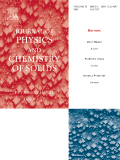
JOURNAL OF PHYSICS AND CHEMISTRY OF SOLIDS
Unveiling the Mysteries of Solid-State MaterialsJOURNAL OF PHYSICS AND CHEMISTRY OF SOLIDS, published by Pergamon-Elsevier Science Ltd, is a distinguished international journal that has been at the forefront of disseminating cutting-edge research in the fields of physics, chemistry, and materials science since its inception in 1956. This journal, which is recognized for its high impact in the Q2 category across multiple subjects—including Chemistry (miscellaneous), Condensed Matter Physics, and Materials Science—serves as a vital platform for researchers, professionals, and students to engage with significant advances in solid-state physics and chemistry. With Scopus rankings placing it in the top 15% of its field across various domains, the journal plays a crucial role in shaping the scientific dialogue surrounding materials properties, synthesis, and applications. Although it does not currently offer open access options, the presented research is widely recognized for its quality and relevance, ensuring that published works contribute meaningfully to ongoing scholarly discussions.
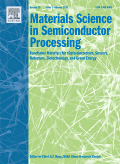
MATERIALS SCIENCE IN SEMICONDUCTOR PROCESSING
Illuminating the Path of Advanced Material ProcessingMATERIALS SCIENCE IN SEMICONDUCTOR PROCESSING, published by ELSEVIER SCI LTD, is a premier journal dedicated to advancing knowledge in the field of semiconductor processing, an area pivotal to the development of modern electronic applications. With an ISSN of 1369-8001 and an E-ISSN of 1873-4081, this journal exemplifies excellence with a remarkable standing in various disciplines, as indicated by its 2023 Scopus rankings—occupying the top quartile (Q1) in Condensed Matter Physics and Mechanical Engineering, and Q2 in Materials Science and Mechanics of Materials. The journal not only provides a platform for high-impact original research, reviews, and significant findings but also bridges theoretical and practical implications within the field. Operating under a publication timeline that extends from 1998 to 2025, it remains an essential resource for researchers, professionals, and students seeking to deepen their understanding of semiconductor materials and processes. Although not an open-access journal, it offers robust options for access, ensuring that cutting-edge developments are made available to the scholarly community.

Small Structures
Pioneering insights for a sustainable future.Small Structures, published by WILEY, is a pioneering open access journal launched in 2023, dedicated to advancing research and innovation across multidisciplinary fields including Environmental Science, Engineering, Materials Science, Chemistry, and Energy. With a commendable impact reflected in its Scopus rankings—holding the 5th position in Environmental Science and 6th in Engineering, among others—the journal facilitates the dissemination of high-quality, peer-reviewed research that drives scientific progress. It operates under an open access model, ensuring that vital insights and findings are freely accessible to researchers, professionals, and students alike, fostering collaboration and advancements in small-scale structures and their applications. Located in Hoboken, NJ, Small Structures not only aims to enrich the understanding of complexities within materials and their environmental impacts but also aspires to serve as a critical resource for the global scientific community.
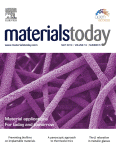
Materials Today
Driving Excellence in Material InnovationsMaterials Today is a premier academic journal published by Elsevier Science Ltd, specializing in the dynamic fields of materials science, mechanical engineering, and condensed matter physics. Established in 1999, the journal has garnered an enviable reputation, consistently ranking in the Q1 category across multiple disciplines including mechanics of materials and general materials science, reflecting its influence and high-quality research output. With an impressive Scopus ranking—4th in both mechanical engineering and mechanics of materials, and 6th in condensed matter physics—Materials Today serves as an essential resource for researchers, professionals, and students seeking to stay at the forefront of developments in material innovations and applications. The journal is known for its commitment to publishing significant research findings and reviews, making it a vital platform for disseminating knowledge and fostering collaboration in the rapidly evolving materials field. Although it does not offer open access, its robust impact factor underscores the importance of the content published, ensuring wide visibility and citation among the academic community. Explore the rich tapestry of materials research with Materials Today, where groundbreaking insights pave the way for future technological advancements.
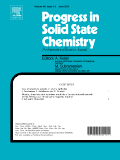
PROGRESS IN SOLID STATE CHEMISTRY
Exploring the Depths of Solid State ResearchPROGRESS IN SOLID STATE CHEMISTRY, published by PERGAMON-ELSEVIER SCIENCE LTD, serves as a pivotal platform for disseminating cutting-edge research and advancements in the field of solid state chemistry. With an impressive impact factor and a respected status, this journal consistently ranks in the Q1 category across multiple disciplines, including Condensed Matter Physics, Materials Science, and Physical and Theoretical Chemistry. Following a rigorous peer-review process, it features articles that explore theoretical frameworks and experimental findings, thereby fostering innovation and collaboration among researchers and professionals. Although it does not adopt an open access model, its substantial reach and high Scopus rankings—19th in Condensed Matter Physics, 14th in Physical and Theoretical Chemistry, and 48th in General Materials Science—underscore its influence in shaping the future of materials research. Established in 1964, the journal continues to contribute significantly to the academic community, bridging the gap between theory and practical application in solid state materials.
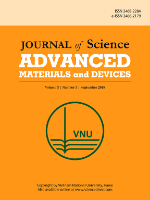
Journal of Science-Advanced Materials and Devices
Advancing Materials Science Through Open Access InnovationJournal of Science-Advanced Materials and Devices is a leading open-access journal published by Vietnam National University, dedicated to advancing the field of materials science through cutting-edge research and innovative developments. Since its inception in 2016, this journal has become a pivotal platform for sharing insights and discoveries in various subfields, including biomaterials, ceramics and composites, and electronic, optical, and magnetic materials. With impressive quartile rankings, including Q1 across multiple categories in 2023, and a notable Scopus ranking placing it in the top 15th percentile for ceramics and composites, it highlights the journal’s influence and prestige within the global academic community. Open Access since its launch, the journal aims to facilitate unrestricted dissemination of scholarly work, empowering researchers, professionals, and students to engage with the latest advancements. The Journal of Science-Advanced Materials and Devices is vital for those seeking high-quality contributions that influence both theoretical understanding and practical applications in the ever-evolving landscape of materials science.
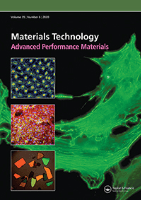
MATERIALS TECHNOLOGY
Pioneering Research in Materials ScienceMATERIALS TECHNOLOGY is a prestigious academic journal published by Taylor & Francis Ltd, based in the United Kingdom. With an ISSN of 1066-7857 and an E-ISSN of 1753-5557, this journal has established itself as a vital resource in the fields of Condensed Matter Physics, Materials Science, Mechanical Engineering, and Mechanics of Materials, earning a Q2 ranking in multiple categories as of 2023. With a rich publication history that dates back to the early 1970s, it serves as an essential platform for disseminating innovative research and developments in materials technology. Although not available through Open Access, the journal continues to attract contributions from leading researchers, ensuring high-quality articles that advance knowledge in the materials domain. The journal's commitment to excellence is reflected in its notable Scopus rankings, placing it within the 70th to 78th percentiles across several engineering and physics categories. As a vital resource for researchers, professionals, and students alike, MATERIALS TECHNOLOGY plays a critical role in shaping the future of materials science and engineering.